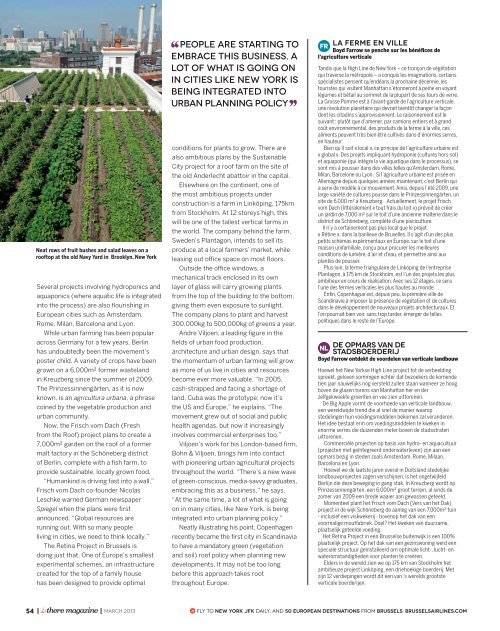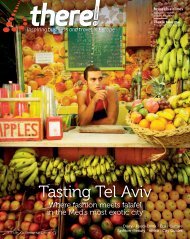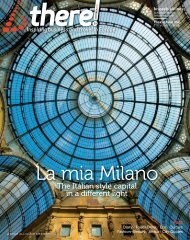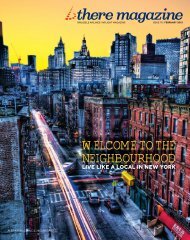march-2013
march-2013
march-2013
Create successful ePaper yourself
Turn your PDF publications into a flip-book with our unique Google optimized e-Paper software.
54<br />
BUSINESS<br />
Neat rows of fruit bushes and salad leaves on a<br />
rooftop at the old Navy Yard in Brooklyn, New York<br />
Several projects involving hydroponics and<br />
aquaponics (where aquatic life is integrated<br />
into the process) are also flourishing in<br />
European cities such as Amsterdam,<br />
Rome, Milan, Barcelona and Lyon.<br />
While urban farming has been popular<br />
across Germany for a few years, Berlin<br />
has undoubtedly been the movement’s<br />
poster child. A variety of crops have been<br />
grown on a 6,000m² former wasteland<br />
in Kreuzberg since the summer of 2009.<br />
The Prinzessinnengärten, as it is now<br />
known, is an agricultura urbana, a phrase<br />
coined by the vegetable production and<br />
urban community.<br />
Now, the Frisch vom Dach (Fresh<br />
from the Roof) project plans to create a<br />
7,000m² garden on the roof of a former<br />
malt factory in the Schöneberg district<br />
of Berlin, complete with a fish farm, to<br />
provide sustainable, locally grown food.<br />
“Humankind is driving fast into a wall,”<br />
Frisch vom Dach co-founder Nicolas<br />
Leschke warned German newspaper<br />
Spiegel when the plans were first<br />
announced. “Global resources are<br />
running out. With so many people<br />
living in cities, we need to think locally.”<br />
The Retina Project in Brussels is<br />
doing just that. One of Europe’s smallest<br />
experimental schemes, an infrastructure<br />
created for the top of a family house<br />
has been designed to provide optimal<br />
<strong>march</strong> <strong>2013</strong><br />
people are starting to<br />
embrace this business. a<br />
lot of what is going on<br />
in cities like new york is<br />
being integrated into<br />
urban planning policy<br />
conditions for plants to grow. There are<br />
also ambitious plans by the Sustainable<br />
City project for a roof farm on the site of<br />
the old Anderlecht abattoir in the capital.<br />
Elsewhere on the continent, one of<br />
the most ambitious projects under<br />
construction is a farm in Linköping, 175km<br />
from Stockholm. At 12 storeys high, this<br />
will be one of the tallest vertical farms in<br />
the world. The company behind the farm,<br />
Sweden’s Plantagon, intends to sell its<br />
produce at a local farmers’ market, while<br />
leasing out office space on most floors.<br />
Outside the office windows, a<br />
mechanical track enclosed in its own<br />
layer of glass will carry growing plants<br />
from the top of the building to the bottom,<br />
giving them even exposure to sunlight.<br />
The company plans to plant and harvest<br />
300,000kg to 500,000kg of greens a year.<br />
Andre Viljoen, a leading figure in the<br />
fields of urban food production,<br />
architecture and urban design, says that<br />
the momentum of urban farming will grow<br />
as more of us live in cities and resources<br />
become ever more valuable. “In 2005,<br />
cash-strapped and facing a shortage of<br />
land, Cuba was the prototype; now it’s<br />
the US and Europe,” he explains. “The<br />
movement grew out of social and public<br />
health agendas, but now it increasingly<br />
involves commercial enterprises too.”<br />
Viljoen’s work for his London-based firm,<br />
Bohn & Viljoen, brings him into contact<br />
with pioneering urban agricultural projects<br />
throughout the world. “There’s a new wave<br />
of green-conscious, media-savvy graduates,<br />
embracing this as a business,” he says.<br />
“At the same time, a lot of what is going<br />
on in many cities, like New York, is being<br />
integrated into urban planning policy.”<br />
Neatly illustrating his point, Copenhagen<br />
recently became the first city in Scandinavia<br />
to have a mandatory green (vegetation<br />
and soil) roof policy when planning new<br />
developments. It may not be too long<br />
before this approach takes root<br />
throughout Europe.<br />
FR La ferme en ville<br />
Boyd Farrow se penche sur les bénéfi ces de<br />
l’agriculture verticale<br />
Tandis que la High Line de New York – ce tronçon de végétation<br />
qui traverse la métropole – a conquis les imaginations, certains<br />
spécialistes pensent qu’endéans la prochaine décennie, les<br />
touristes qui visitent Manhattan s’étonneront à peine en voyant<br />
légumes et bétail au sommet de la plupart de ses tours de verre.<br />
La Grosse Pomme est à l’avant-garde de l’agriculture verticale,<br />
une révolution planétaire qui devrait bientôt changer la façon<br />
dont les citadins s’approvisionnent. Le raisonnement est le<br />
suivant : plutôt que d’amener, par camions entiers et à grand<br />
coût environnemental, des produits de la ferme à la ville, ces<br />
aliments peuvent très bien être cultivés dans d’énormes serres,<br />
en hauteur.<br />
Bien qu’il soit « local », ce principe de l’agriculture urbaine est<br />
« global ». Des projets impliquant hydroponie (cultures hors-sol)<br />
et aquaponie (qui intègre la vie aquatique dans le processus), se<br />
sont mis à pousser dans des villes telles qu’Amsterdam, Rome,<br />
Milan, Barcelone ou Lyon. Si l’agriculture urbaine est prisée en<br />
Allemagne depuis quelques années maintenant, c’est Berlin qui<br />
a servi de modèle à ce mouvement. Ainsi, depuis l’été 2009, une<br />
large variété de cultures pousse dans le Prinzessinnengärten, un<br />
site de 6.000 m² à Kreuzberg. Actuellement, le projet Frisch<br />
vom Dach (littéralement « tout frais du toit ») prévoit de créer<br />
un jardin de 7.000 m² sur le toit d’une ancienne malterie dans le<br />
district de Schöneberg, complété d’une pisciculture.<br />
Il n’y a certainement pas plus local que le projet<br />
« Rétine », dans la banlieue de Bruxelles. Il s’agit d’un des plus<br />
petits schémas expérimentaux en Europe, sur le toit d’une<br />
maison unifamiliale, conçu pour procurer les meilleures<br />
conditions de lumière, d’air et d’eau, et permettre ainsi aux<br />
plantes de pousser.<br />
Plus loin, la ferme triangulaire de Linköping de l’entreprise<br />
Plantagon, à 175 km de Stockholm, est l’un des projets les plus<br />
ambitieux en cours de réalisation. Avec ses 12 étages, ce sera<br />
l’une des fermes verticales les plus hautes au monde.<br />
Enfi n, Copenhague est, depuis peu, la première ville de<br />
Scandinavie à imposer la présence de végétation et de cultures<br />
dans le développement de nouveaux projets architecturaux. Et<br />
l’on pourrait bien voir, sans trop tarder, émerger de telles<br />
politiques dans le reste de l’Europe.<br />
NL<br />
De opmars van de<br />
stadsboerderij<br />
Boyd Farrow ontdekt de voordelen van verticale landbouw<br />
Hoewel het New Yorkse High Line project tot de verbeelding<br />
spreekt, geloven sommigen echter dat bezoekers de komende<br />
tien jaar nauwelijks nog versteld zullen staan wanneer ze hoog<br />
boven de glazen torens van Manhattan her en der<br />
zelfgekweekte groenten en vee zien uittorenen.<br />
De Big Apple vormt de voorhoede van verticale landbouw,<br />
een wereldwijde trend die al snel de manier waarop<br />
stedelingen hun voedingsmiddelen bekomen zal veranderen.<br />
Het idee bestaat erin om voedingsmiddelen te kweken in<br />
enorme serres die duizenden meter boven de stadsstraten<br />
uittorenen.<br />
Commerciële projecten op basis van hydro- en aquacultuur<br />
(projecten met geïntegreerd onderwaterleven) zijn aan een<br />
opmars bezig in steden zoals Amsterdam, Rome, Milaan,<br />
Barcelona en Lyon.<br />
Hoewel we de laatste jaren overal in Duitsland stedelijke<br />
landbouwprojecten zagen verschijnen, is het ongetwijfeld<br />
Berlijn die deze beweging in gang stak. In Kreuzberg wordt op<br />
Prinzessinnengärten, een 6.000m² groot terrein, al sinds de<br />
zomer van 2009 een brede waaier aan gewassen geteeld.<br />
Momenteel plant het Frisch vom Dach (Vers van het Dak)<br />
project in de wijk Schöneberg de aanleg van een 7.000m² tuin<br />
- inclusief een viskwekerij - bovenop het dak van een<br />
voormalige moutfabriek. Doel? Het kweken van duurzame,<br />
plaatselijk geteelde voeding.<br />
Het Retina Project in een Brusselse buitenwijk is een 100%<br />
plaatselijk project. Op het dak van een gezinswoning werd een<br />
speciale structuur geïnstalleerd om optimale licht-, lucht- en<br />
wateromstandigheden voor planten te creëren.<br />
Elders in de wereld zien we op 175 km van Stockholm het<br />
ambitieuze project Linköping, een driehoekige boerderij. Met<br />
zijn 12 verdiepingen wordt dit een van ’s werelds grootste<br />
verticale boerderijen.<br />
FLY TO new york JFK daily; and 50 european destinations from brussels. brusselsairlines.com
















